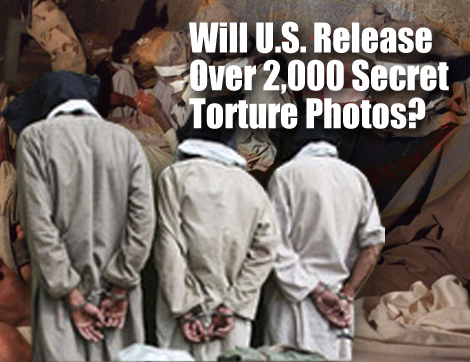
• ‘National security’ no longer a defensible excuse to continue to hide evidence of U.S. abuse of prisoners.
By Olga Belinskaya —
For over 10 years, the United States Department of Defense has been battling a lawsuit brought by the American Civil Liberties Union (ACLU), which wants access to horrific images of torture and abuse in Iraq and Afghanistan carried out by U.S. intelligence agencies and the military.
Recently, U.S. District Judge Alvin Hellerstein gave the Obama administration until December 12 to justify withholding as many as 2,100 photographs depicting the torture of prisoners. The government’s response is expected to be its most detailed argument for secrecy yet.
“Americans have a right to know what was done in our names in military detention centers,” said Marcellene Hearn, the senior staff attorney for the ACLU’s National Security Project .
The images are suspected to be similar to the more than 1,300 photographs taken at the Abu Ghraib Prison in Iraq that were released in 2006. The Abu Ghraib images depicted prisoners crawling on the floor naked, being forced to perform sexual acts, being covered in feces and attacked by dogs. Some images also showed prisoners killed by the soldiers, some shot in the head and some with slit throats.
In 2009, the Obama administration concealed the images in question with the Protected National Security Documents Act of 2009, which allows an image to remain secret for three years if release endangers Americans. At the time, President Barack Hussein Obama said: “The individuals who were involved have been identified, and appropriate actions have been taken. It’s therefore my belief that the publication of these photos would not add any additional benefit to our understanding of what was carried out in the past by a small number of individuals. In fact, the most direct consequence of releasing them, I believe, would be to further inflame anti-American opinion and to put our troops in greater danger.”
Ms. Hearn responded: “It would be completely backwards to suppress images of government misconduct on the grounds that they are too powerful to be disclosed when it is often disclosure, accountability and ensuing reforms that prevent misconduct from recurring.”
In his ruling, Hellerstein quoted British economist John Maynard Keynes: “When the facts change, I change my mind. What do you do, sir?”
The Iraq War is over, and almost all soldiers have been withdrawn, so the argument that the photos endanger Americans is weak. The burden of proof is now on the government to show why the publication of images risks national security.
Hellerstein’s ruling for transparency was joined by an October 3 federal district court ruling to release 28 classified military videotapes showing the forced cell extraction and forced feeding of a hunger-striking Guantanamo Bay detainee, Jihad Ahmed Mujstafa Diyab, a Syrian who has been held for 12 years without a trial.
Judge Gladys Kessler rejected the Obama administration’s arguments that making the videos public would endanger national security. Judge Kessler cited the First Amendment in overriding the government’s arguments for keeping the videos secret. She added that the “national security” arguments were “unacceptably vague, speculative,” lacking specificity or “just plain implausible.” Judge Kessler also ruled that hearings about force-feeding would be public.
Another major torture disclosure may soon follow. The Senate Intelligence Committee voted six months ago to release its findings of a landmark study on the Central Intelligence Agency’s torture program. The committee is currently pushing back against the administration’s efforts to censor much of the report to make it unreadable.
The push for secrecy isn’t surprising, considering the hellish conditions in Abu Ghraib. Saddam Salah al-Rawi, who was in one of the infamous photographs recalls: “In my cell I was shouting: ‘Please come and take me. Please kill me. I am Osama bin Laden, I was in the plane that hit the World Trade Center.’ I wanted to be dead 1,000 times. I asked my God to take my soul.”
Olga Belinskaya is a native of Ukraine and is AFP’s former bookstore manager. She is currently a peace and monetary reform activist based in Virginia.


